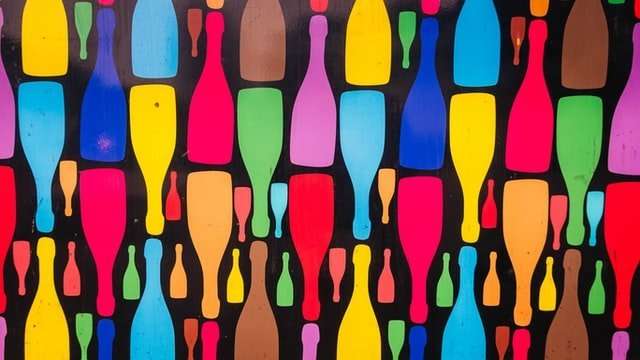Collage art and digital art are similar.
Collage art is an old, traditional form of art. It has been around for centuries. The first collage is the one you made in kindergarten: the paper with the magazine pictures glued to it. Digital art is also a new, emerging form of art that exists in a variety of forms on computers and other digital devices such as tablets, cell phones, and video game consoles.
Trying to define what is distinctively collage is difficult because collage has taken on so many forms over the years. Basically all you have to do is put together two or more images to make a new image that expresses some idea or emotion.
The definition of digital art is easier to come up with because there are only a few forms it takes. It can be simple or complex, colorful or black and white, and it can even be completely abstract but it must use technology in some way in its creation from start to finish.* (This includes using programs like Photoshop)
Collage and digital art are similar in other ways too. They both use images from various sources such as magazines, books, television shows, photographs etc. They both use computer software such as Photoshop and Illustrator to manipulate the images and create new ones.*
I think it’s a little ironic that the hobby of so many people – who are actually creative – is to go and find things on the internet that are creative. I’m not saying that’s wrong, but it seems to me there must be something better we can do with our time?
Well, yes and no. Some ‘collage artists’ spend as much time finding images for their collage as they do creating it. So, in that case I’d say don’t bother. Don’t create a blog to find more stuff to put in your collage. Just create the collage.
But, if you’re going to create a collage anyway… Why not take the extra step and share it with other people? That way, you’re creating a blog, which can have its own ‘voice’ and personality (if you let it). And it’s not a bad thing to have a blog/website – right now, we’re living through an age where every artist has essentially become his/her own marketing department. It’s your career! You need to control it! This means having your own website or blog where you can talk about your work. It’s also a good way to increase traffic on your website/blog and get more views for
The pictures in our collages are made up of so many different things that the work changes when you add a new element. So if your image includes a person, you should make sure that the person’s eyes are open. A lot of people think that eyes can’t be seen unless “they are looking at something” or “their lips are closed.” Whether you first use real people or images from magazines, it is important to remember this rule.
When you have found and cut out all the images in your collage, sometimes there is leftover space. We recommend that you use this space to create a background for your collage. This will make sure that it doesn’t look like it was thrown together. It will also provide a nice contrast to all the busy details in your piece.
Image credit: Collage by Céline Vetter and Emma Storvik
Collage art is a form of art and design in which a work is created from various materials and objects that are cut, pasted, or glued onto a canvas. The word collage comes from the French word coller, which means “to stick”. Collage is often used as an art form or technique. The traditional medium for collage was the paper scrapbooks and cut-outs made by children.
The term “collage” was coined by both Georges Braque and Pablo Picasso in the beginning of the 20th century when they began to create works out of found objects.
It’s not often that you can find free, high-quality resources on the Internet. You know that, right?
Well, here’s a trove of beautiful, royalty-free photos from the Stocksy United collection. So head on over and download some amazing graphics for your next project.
I’ll wait.
Okay, back already? Good! Now you’ve got all those amazing images to look at (and use in your projects), so we need to get started…
First thing you’ll want to do is set up a new folder on your computer for these photos and then drag them into it. There’s no sense in letting them get lost in the shuffle with everything else you’ve got going on. To do this, go to File > New Folder (or press Ctrl+Shift+N) and then type out a name for your new folder.
Remember that one? Great!
Now we’re going to set up a basic layout with some margins around these images. For this tutorial, we’ll be using Adobe Illustrator as our program of choice – but you can use whatever you like best! So if you don’t have Illustrator, don’t worry: there are lots of other great options out there that will still make this tutorial work
Collage is an art form in which a piece of artwork is created from pieces of preexisting artwork. Collage, as well as the broader concept of mixed media, arose out of Cubism and Dada. The Dadaists in particular are credited with coining the term collage in the late 1910s.
Tate Modern’s online magazine ‘The Pool’ has published a number of articles on collage. They note that:
“Collage was first used as a term to describe the works of Picasso and Braque: they took fragments of images from printed matter such as newspapers or photographs and stuck them onto their paintings in order to question the nature of representation and create more complicated imagery.”
However, techniques would be adopted and applied by others outside the realm of fine art. For example, during World War I soldiers would use photographs taken by friends or family members to create pictures to send back home. These were called “postal cards,” and typically showed scenes of where they were stationed, or other parts of their lives while abroad.
The practice has been revived by modern artists working in a wide variety of media to add another layer to their work.”
When I was about 16, it occurred to me that I might be able to make a living as a visual artist. It wasn’t too much of a stretch; after all, I had been making art since I was five. And though I’d never heard anyone say so, it seemed like it might be possible to assemble a coherent and sustainable career out of the work that artists do anyway: drawing, painting, sculpting and so on. (It never occurred to me there were other things artists did.) And if you could make a living, then maybe you could make a name for yourself, or at least have an interesting life.
What I didn’t realize is that having an interesting life was what my mother would regard as an insufficient reason to get up in the morning. In her view, you don’t do something because it’s interesting — you do it because it’s good for you.
I hadn’t thought that through before deciding to become an artist. But it turned out not to matter much; I discovered that deciding to become an artist isn’t the same thing as becoming one. The world doesn’t offer many clear paths to being a successful visual artist, and no one seems quite sure what exactly constitutes success. My friends who wanted to be writers had been


